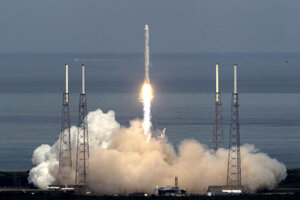As SpaceX plans its next blastoff, here's how it aims to stick the landing
SpaceX plans to launch a new version of its Falcon 9 rocket next week, to deliver 11 satellites into Low Earth Orbit. SpaceX will try a third time to soft-land the first rocket stage – this time on solid ground, rather than on a floating barge.

SpaceX will launch an upgraded Falcon 9 rocket on December 19. Here, a Falcon 9 test rocket lifts off from Cape Canaveral in 2012.
John Raoux/AP/File
The commercial space race is back on. On Wednesday, Orbital ATK’s Cygnus spacecraft, loaded with more than 7,000 pounds of crew supplies and experiments, reached the International Space Station. And on December 19, SpaceX, which hasn’t attempted a launch since one of its Falcon 9 rockets exploded minutes after liftoff in June, will take to the skies again to deliver 11 communications satellites into Low Earth Orbit.
SpaceX says a faulty steel strut was the culprit in the June explosion, and that from now on it will test each strut individually before launches.
But the company also plans to resume trying to achieve a bigger goal: recovering the rocket’s first stage after separation. Since January, SpaceX has made two attempts to gently land the Falcon 9 on a small barge floating in the Atlantic Ocean. During the first attempt, the rocket ran out of hydraulic fluid and crashed into the barge; during the second, the rocket touched down but then tipped over.
The upcoming launch will test an enhanced version of the Falcon 9 that should be a bit easier to land, thanks to engines that can deliver more thrust. SpaceX plans to attempt the landing not on a floating barge, but on solid ground near the launch site in Cape Canaveral, Florida.
Last month Blue Origin, a spaceflight company that plans to ferry tourists to the edge of space on short sub-orbital flights, made headlines by soft-landing its New Shepard rocket on a pad near its Texas launch site.
It’s easy to compare the two companies: Blue Origin made a successful landing, while SpaceX has tried and failed twice to do so. But landing a Falcon 9 is quite a bit more complicated. SpaceX's craft is significantly taller, faster, and more powerful, not to mention that the first stage reaches a height of 124 miles – twice the height of New Shepard’s apogee – before it comes back to Earth. A Falcon 9 is also horizontal relative to the Earth’s surface when it begins falling, meaning that the first stage has to be flipped vertically before landing.
If SpaceX can stick this landing, it will be the first time an orbital rocket will have been recovered intact. (The recovery is part of SpaceX’s overall plan to bring down the cost of going to space, since it’s much cheaper to send a rocket on multiple flights than to build a new one from scratch each time.)
SpaceX and Orbital ATK are competing, along with Sierra Nevada Corporation, for a seven-year NASA contract to deliver supplies to the ISS beginning in 2017. This contract will allow NASA to shift its focus away from Low Earth Orbit and toward more ambitious deep-space missions, while ensuring that supplies (and, eventually, astronauts) are launched using American technology rather than aboard antiquated Russian Soyuz craft.

